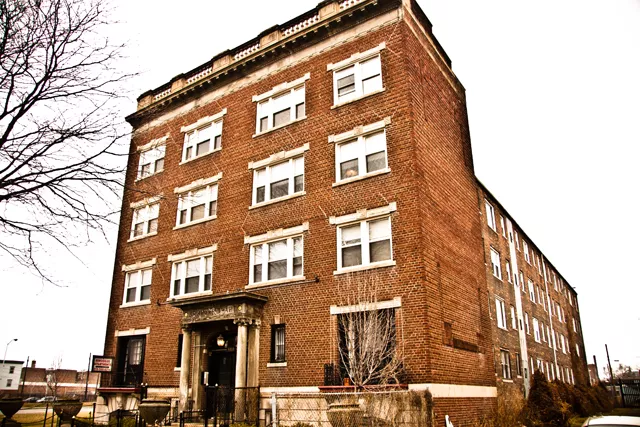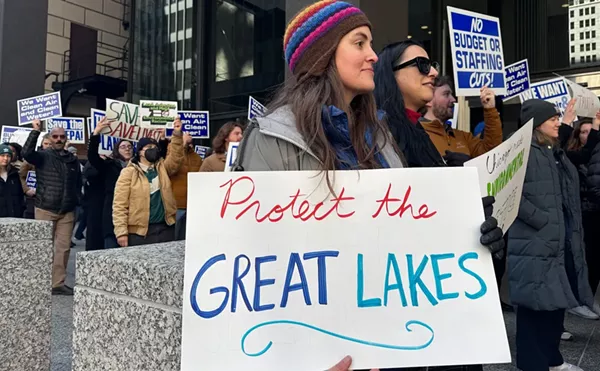When Jen and Randy Lewarchik purchased the apartment building six years ago, they knew the 90-year-old structure needed some work. Its intricate tile flooring, aged wood fixtures and leaky roof had been neglected for decades.
The couple was taking inventory of the basement when they found the sign: "This building will be open in May 1935."
"To my knowledge, that was the last time it was refurbished," Randy Lewarchik says.
Since then, the Lewarchiks have renovated, modernized and "greened" many of the 47 one-bedroom and studio units, the hallways and the operating systems of the building, located at Brainard Street and Second Avenue in the Cass Corridor.
Like others in the green building movement around the city and the country, they're looking to improve efficiency, save on utility bills and do what's right for the environment, they say.
And they're hoping to do it with the help of a federal program that has allocated $30 million for green building improvements in Michigan. About $10 million of that is earmarked for public and commercial buildings roughly along the Woodward Corridor in downtown Detroit.
"These buildings are old. They need some TLC. We're trying to package this to be the tipping point so the work gets done and the buildings don't continue to languish in terms of their energy efficiency," says Scott Veldhuis, senior project manager at the Detroit Economic Growth Corp., which approves the projects and helps administer the SmartBuildings Detroit Program.
Projects can receive grants of as much as 25 percent and loans of as much as 40 percent of total costs to a maximum of $100,000. They can include digital thermostats, building sealant, better insulation, windows and more advanced technologies, such as solar panels and geothermal systems.
"When the grant was finalized, we helped think through a process that would work for building owners to enable them to understand the energy needs of their building and also the financing needs," says Diane Van Buren, a consultant with Henry Ford Community College's Michigan Technical Education Center.
Of the $10 million, about $6.1 million is for public and institutional buildings, and $3.9 million for privately owned structures. Of the $3.9 million, $1 million is a loan pool, $1.9 million is for direct grants and $1 million is for administration, energy assessments, a training component and follow-up on the projects, Van Buren says.
Recruitment of private owners like the Lewarchiks has just started, Veldhuis says. Funded by the American Recovery and Reinvestment Act (ARRA) — better known as "stimulus money" — the SmartBuilding program makes the $10 million available in an area of roughly bordered by the river, the New Center, the Lodge Expressway and I-75. The $10 million is part of $30 million that was awarded to the state through the ARRA grant. About $20 million is being funneled to residential improvements through a number of organizations. The Detroit Economic Growth Corp., a quasi-public branch of the city, is overseeing the $10 million commercial component.
DEGC's board last year approved $3.8 million worth of projects at Cobo Center and the Coleman A. Young Municipal Center that were the start of the public and institutional projects. Money will help pay for energy-efficient glass, a green roof, upgraded lighting and replacing aging air conditioning equipment at the city-county complex. Cobo will get better roof insulation, more efficient lighting and escalators as well as other improvements. In all, there are funds for dozens of buildings of varying sizes.
The Lewarchiks say they'd use the money for even more improvements than they've made already. As part of the Brainard building's overhaul that began in 2005, most of the windows got double-paned glass, the electrical system got updates, the roof became reflective, and the boiler system was upgraded.
"But there are additional things that can be done to improve it even more," Randy Lewarchik says. For example, regulating the steam heat's temperature in each unit remains an issue. "A lot of people don't complain. ... When it's too hot, they just open the windows," Jen Lewarchik says. "Obviously that's not good."
Lewarchiks' plans include solar panels, and they'd like to recycle water for a garden at the lot they own next to the building. Randy Lewarchik says he's not sure what improvements he'll eventually make, but they could total $250,000.
"We're still waiting to see all the different funds and how it's all going to work," Randy says. "I won't know 100 percent until funding gives me a thumbs-up."
One of his goals is to lower his utility bills by $1,500 a month. Currently tenants at the Brainard property pay their individual electric bills but the Lewarchiks pay the heat, cooking gas and water bills.
"In Detroit, it's tight. Every penny matters. It helps the bottom line as well as the environment and that's good too," he says.
As part of the Lewarchik's funding application, energy analysts from WARM Training Center, a nonprofit specializing in energy efficiency, walked through the building this week.
Carrie Da Via and Erinn Fahey, energy analysts, found plenty to recommend. Older windows were drafty, and some doors didn't seal completely, for instance. A more extensive evaluation will be presented to the Lewarchiks, along with an analysis of their utility bills.
Such leaks in what Da Via calls the building's "envelope" are the most common finding in evaluations. The result, she says: "You're losing a ton of heat."
WARM is doing the evaluations of commercial buildings under the ARRA grant. Since money needs to be allocated by December, Da Via expects the 40 buildings they have funding for to be completed by year's end.
The evaluations, she says, are short of a full, more technical audit but are the first step for building owners. "We could recommend an engineering study if, for example, someone needed HVAC looked at," she says. "With an evaluation, they'll still have enough information to help them."
Like all federal stimulus projects, the program aims to create jobs. Those extend from the initial evaluation to construction and installation of "green" materials in the building.
But the other longer-term benefit is the energy savings for building owners that could last for decades. Part of the grant's requirements is that DEGC track and report energy costs in the buildings.
"We're going to be reporting the energy savings that are realized in each of these projects. We're going to have, ultimately, by the time we're finished, a pretty comprehensive database of information on a variety of projects," Veldhuis says.







